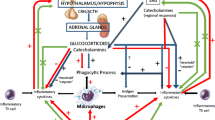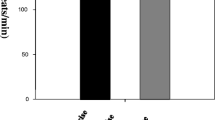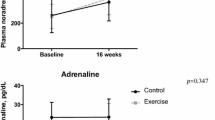Abstract
During intensive exercise the stimulation of phagocytosis is mediated by “stress hormones”. During moderate exercise, however, such mediation is less clear. The influence of moderate exercise (45 min at 55% maximal oxygen uptake) on the phagocytic capacity of neutrophils was evaluated in sedentary men. The exercise stimulated phagocytosis of Candida albicans, and the stimulation was maintained for at least 24 h. The possible neuroendocrine mediators were then investigated. Stimulation of phagocytosis was found after incubating neutrophils from sedentary individuals, who were in a basal state, with plasma from exercised individuals. Immediately after exercise, there was a significant increase in the concentration of norepinephrine, but not of epinephrine or cortisol. Incubation of neutrophils with this post-exercise physiological concentration of norepinephrine also stimulated phagocytosis, and the effect was blocked by both propranolol and phentolamine. The norepinephrine-augmented phagocytosis was accompanied by an increase in intracellular levels of cAMP, but not of cGMP or calcium. In conclusion, moderate exercise performed by sedentary people stimulates the phagocytic capacity of neutrophils, and the stimulation lasts for at least 24 h. Norepinephrine mediates the stimulation, although other mechanisms could be involved during the recovery period.




Similar content being viewed by others
References
Alteraifi AM, Zhelev DV (1997) Transient increase of free cytosolic calcium during neutrophil motility responses. J Cell Sci 110:1967–1977
Blannin AK, Chatwin LJ, Cave R, Gleeson M (1996) Effects of submaximal cycling and long-term endurance training on neutrophil phagocytic activity in middle aged men. Br J Sports Med 30:125–129
Brenner I, Shek PN, Zamecnik J, Shephard RJ (1998) Stress hormones and the immunological responses to heat and exercise. Int J Sports Med 19:130–143
Coffey RG (1992) Effects of cyclic nucleotides on granulocytes. Immunol Ser 57:301–338
Fitzgerald L (1998) Exercise and the immune system. Immunol Today 9:337–339
Forner MA, Barriga C, Rodríguez AB, Ortega E (1995) A study of the role of corticosterone as a mediator in exercise-induced stimulation of murine macrophage phagocytosis. J Physiol (Lond) 488:789–794
García JJ, Sáez MC, De la Fuente M, Ortega E (2003) Regulation of phagocytic process of macrophages by norepinephrine and its end metabolite 4-hydroxy-3-metoxyphenyl-glycol. Role of α- and β-adrenoreceptors. Mol Cell Biochem 254:299–304
Hack V, Strobel G, Weiss M, Weicker H (1994) PMN cell counts and phagocytic activity of highly trained athletes depend on training period. J Appl Physiol 77:1731–1735
Hoffman-Goetz L, Pedersen BK (1994) Exercise and the immune system: a model of the stress response? Immunol Today 15:382–387
Krause R, Patruta S, Daxbock F, Fladerer P, Biegelmayer C, Wenisch C (2001) Effect of vitamin C on neutrophil function after high-intensity exercise. Eur J Clin Invest 3:258–263
Nagatomi R, Kaifu T, Okutsu M, Zhang X, Kanemi O, Ohmori H (2000) Modulation of the immune system by the autonomic nervous system and its implication in immunological changes after training. Exerc Immunol Rev 6:54–74
Ortega E (1994) Influence of exercise on phagocytosis. Int J Sports Med 15:S172–S178
Ortega E (2003) Neuroendocrine mediators in the modulation of phagocytosis by exercise: physiological implications. Exerc Immunol Rev 9:70–93
Ortega E, Collazos ME, Maynar M, Barriga C, De la Fuente M (1993) Stimulation of the phagocytic function of neutrophils in sedentary men after acute moderate exercise. Eur J Appl Physiol 66:60–64
Ortega E, García JJ, Sáez MC, De la Fuente M (2000) Changes with aging in the modulation of macrophages by norepinephrine. Mech Ageing Dev 118:103–114
Peake JM (2002) Exercise-induced alterations in neutrophil degranulation and respiratory burst activity: possible mechanism of action. Exerc Immunol Rev 8:49–100
Pedersen BK, Hoffman-Goetz L (2000) Exercise and the immune system: regulation, integration, and adaptation. Physiol Rev 80:1055–1081
Pedersen BK, Bruunsgaard H, Klokker M, Kappel M, MacLean DA, Nielsen HB, Rohde T, Ullum H, Zacho M (1997) Exercise-induced immunomodulation-possible roles of neuroendocrine and metabolic factors. Int J Med 18:S2–S7
Pedersen BK, Rohde T, Ostrowski K (1998) Recovery of the immune system after exercise. Acta Physiol Scand 162:325–332
Poenie M, Tsien R (1986) Fura-2: a powerful new tool for measuring and imaging Ca2+i in single cells. Prog Clin Biol Res 210:53–56
Pyne DB, Smith JA, Baker MS, Telford RD, Weidemann MJ (2000) Neutrophil oxidative activity is differentially affected by exercise intensity and type. J Sci Med Sport 3:44–54
Titinger GR, Theron AJ, Anderson R, Ker JA (2001) The anti-inflammatory interactions of epinephrine with human neutrophils in vitro are achieved by AMP-mediated accelerated requestration of cytosolic calcium. Biochem Pharmacol 61:1319–1328
Weiss M, Schneider EM, Tarnow J, Mettler S, Krone M, Teschemacher A, Lemoine H (1996) Is inhibition of oxygen radical production of neutrophils by sympathomimetics mediated via beta-2 adrenoceptors? J Pharmacol Exp Ther 278:1105–1113
Ydrenius L, Majeed M, Rasmusson BJ, Stendahl O, Sarndahl E (2000) Activation of cAMP-dependent protein kinase is necessary for actin rearrangements in human neutrophils during phagocytosis J Leuk Biol 67:520–528
Zalavary S, Stendahl O, Bengtsson T (1994) The role of cyclic AMP, calcium and filamentous actin in adenosine modulation of Fc receptor-mediated phagocytosis in human neutrophils. Biochim Biophys Acta 1222:249–256
Acknowledgements
The authors thank Ms. Elena Circujano for technical assistance. This investigation was supported in part by grants from the “Consejería de Educación Ciencia y Tecnología” of the “Junta de Extremadura”, “Ministerio de Ciencia y Tecnología”, and “Fondo Social Europeo”.
Author information
Authors and Affiliations
Corresponding author
Rights and permissions
About this article
Cite this article
Ortega, E., Marchena, J.M., García, J.J. et al. Norepinephrine as mediator in the stimulation of phagocytosis induced by moderate exercise. Eur J Appl Physiol 93, 714–718 (2005). https://doi.org/10.1007/s00421-004-1245-8
Accepted:
Published:
Issue Date:
DOI: https://doi.org/10.1007/s00421-004-1245-8




